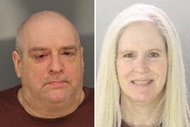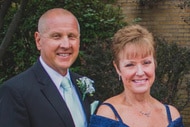Where Is ‘Subway Vigilante’ Bernie Goetz, Who Shot Four Black Teens, Now?
Public debate and a media circus ensued after a white engineer named Bernie Goetz shot four African American teens — Troy Canty, Barry Allen, James Ramseur, and Darrell Cabey – during a confrontation on a NYC subway train.

A quadruple shooting on a New York City subway car during a crime-ridden period in the city’s history ignited a heated public debate over the shooter: was he a trigger-happy bigot or a subway vigilante defending himself?
The incident occurred after four African-American teens — Troy Canty, 19, Barry Allen, 19, James Ramseur, 18, and Darrell Cabey, 19 — approached Bernhard “Bernie” Goetz, then 37, on a southbound 2 train in lower Manhattan on Dec. 22, 1984. Their ensuing exchange has been disputed by the parties involved: they either asked Goetz for $5 or demanded it.
What happened next is not in dispute. Goetz pulled out a handgun and opened fire on the teens, shooting all four of them. Two were struck in the chest and two were shot in the back. While they all survived, Cabey suffered brain damage as a result of his injuries and remains paralyzed to this day.
Before fleeing the scene, Goetz reportedly told the subway conductor that the teens were trying to mug him. Canty and Ramseur later testified that they were merely panhandling. As police searched for the gunman, news of the shooting — along with a sketch of the mysterious shooter — made national and international headlines. New York Post reporter Steve Dunleavy noted in Netflix's “Trial By Media” – a six-episode docuseries that focuses on this contentious case in its second installment – that the incident quickly became a sensational story.
“The press, we dubbed him the ‘Subway Vigilante,’” Dunleavy said. “It probably did create in many people’s minds what a vigilante gunman would look like.”
The incident became symbolic of the rampant crime problem in the city, which was in the depths of the crack cocaine epidemic at the time. Many New Yorkers, tired of muggings and burglaries, empathized with the then-nameless shooter. The media even compared him to Charles Bronson’s character in the 1974 movie “Death Wish.” In the film, Bronson plays a New York City architect who becomes a vigilante after a brutal attack on his wife and daughter.
After weeks of heavy news coverage, Goetz, who had left the city for New England, turned himself in on New Year’s Eve in New Hampshire. He lived in an apartment in Manhattan, on the border of Greenwich Village, that served as the home base for his electronic testing and repair firm. While the glasses-wearing engineer appeared meek, he spoke brazenly about the attack, which fueled debates about crime, self-defense and gun ownership, and racial tensions.
Goetz told investigators that he'd bought a gun in Florida and illegally transported it to New York City after he was violently mugged by three teens four years before the subway shooting. He said they kicked him and tried to push him through a glass door. He applied for a gun permit as a result but was rejected. This led the National Rifle Associate to openly support Goetz and to use him as a poster boy as they advocated for less strict gun laws in New York City.
The gunman became the source of daily tabloid fodder; everywhere he went, so did a crowd of cameras and reporters. He did interviews with Geraldo Rivera and Barbara Walters. His face and name were plastered on shirts and bumper stickers. Lawyer Ron Kuby, who represented Cabey in a civil case against Goetz, told the producers of “Trial by Media” that his client’s mother was “absolutely horrified that the man who did this to her son [was] being lionized as some sort of hero.”
Goetz’ pseudo-hero status began to fade after an interrogation video, which revealed Goetz speaking callously about shooting the teens, was released.
“I wanted to kill those guys,” he exclaimed in the recording. “I wanted to maim those guys.”
He claimed to have shot one of the teens more than once because the boy didn’t seem hurt enough the first time. He recalled telling the boy, "You seem all right, here's another," before shooting him again. Whether or not this verbal exchange, as well as the second shot, happened has been long debated. However, Goetz' sentiment certainly rubbed a lot of people the wrong way.
“You don’t just get up and start firing and shooting four people. How is that self-defense?” the Rev. Al Sharpton noted in the docuseries.
He and other activists accused Goetz of being racist. Sharpton called Goetz’ reaction to the boys an “overreaction that is soaked with race and bigotry.”
Sharpton told reporters at the time, as shown in the docuseries, that Goetz was likely traumatized from the previous mugging and therefore stereotyped all young black men as muggers.
Goetz was acquitted of attempted murder and first-degree assault charges by a mostly white jury in 1987. He was convicted only on a charge of criminal possession of a weapon in the third degree for carrying an unlicensed weapon in a public place. Goetz was sentenced to six months in jail — later extended to one year by an appellate court. Goetz served eight months of that sentence.
In 1996, he was sued for damages in civil court for permanently injuring Cabey. During that trial, Cabey’s lawyers pointed out that Goetz had made racial slurs about black and Hispanic people during a 1980 building association meeting. Goetz admitted using racist slurs during the trial and claimed to have been ashamed that he did.
The mostly non-white jurors determined that Goetz had acted recklessly and had deliberately inflicted emotional distress on Cabey. Cabey was awarded $43 million but never saw any of it because Goetz filed for bankruptcy less than a week after the verdict.
Just one day after the civil trial concluded, a lead editorial in the New York Daily News’ headline stated “No hero, never was” in reference to Goetz.
Where is Goetz now?
Goez, now 72, still lives in the very same apartment in Manhattan, as the docuseries points out. It's unclear what he does for work now.
He unsuccessfully ran for New York City mayor in 2001, telling the Los Angeles Times, “I tell people there are 10 doofuses running for mayor, and I want my name added to the list.”
His mayoral platform proposed installing vegetarian menus at city schools, jails and mental health facilities. Goetz claimed he wouldn’t have been approached on the subway by the teens if he was a vegetarian at the time because “vegetarians have better karma.”
He was arrested in 2013, at age 65, for allegedly selling $30 worth of marijuana to an undercover cop, according to the Los Angeles Times report.
He has become an advocate for New York City’s squirrel population and keeps busy nursing squirrels, he told Newsweek in 2015. He even nurses some of them in his own home, according to a 2014 Narratively feature on him.
Goetz said in a 2017 interview — included at the end of the “Trial by Media” episode — that he had no regrets about the shooting.
“I don't think it's the type of thing you regret,” he said, adding that “there are many things in my life that I regret and I made many, I've made many blunders. I don’t think that was one of them.”
Oxygen.com was unable to reach Goetz for comment.

























